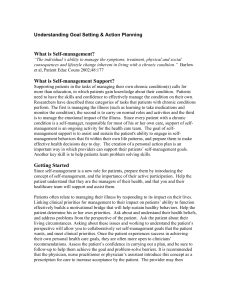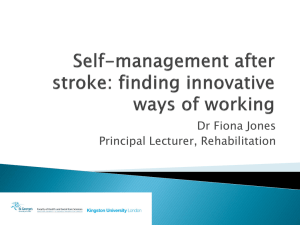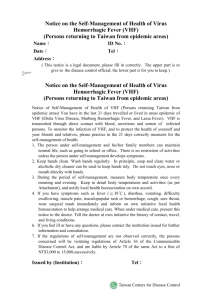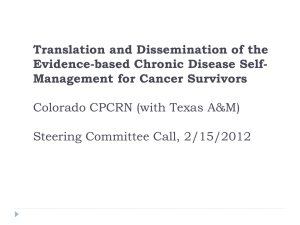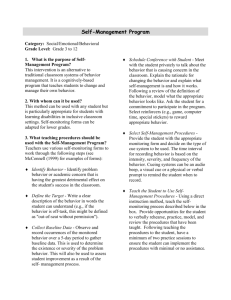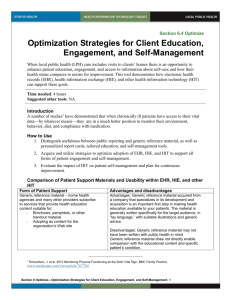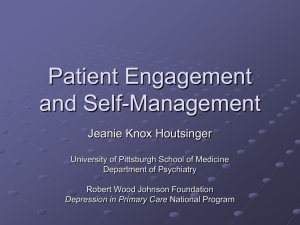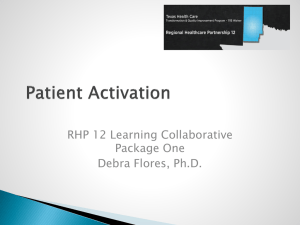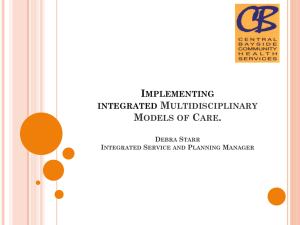Patient Engagement and Self-Management
advertisement
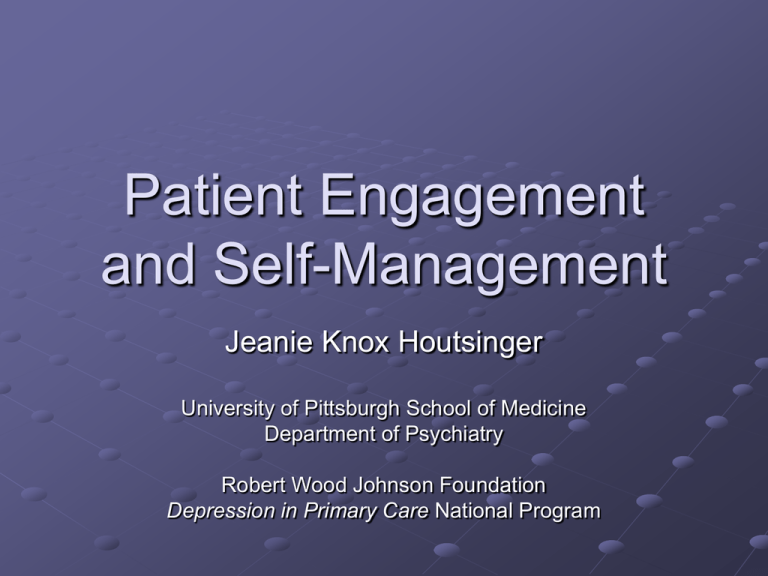
Patient Engagement and Self-Management Jeanie Knox Houtsinger University of Pittsburgh School of Medicine Department of Psychiatry Robert Wood Johnson Foundation Depression in Primary Care National Program Presentation Overview Key concepts related to patient engagement and self-management Why are they critical components of good chronic illness care? Strategies for engaging patients, developing wellness toolkits and working through symptom relapse Definitions Engagement – employing strategies to motivate patients to access and use services and tools to manage their illness. Self Management - process patients can use to look at their health behaviors and then make choices to improve their health based on their knowledge, skills and attitudes. Barriers to Patient Engagement System Barriers Culture Infrastructure Financing Patient Barriers Activation Literacy Diversity Unpredictability Financing System Strategies for Addressing Barriers to Patient Engagement Culture National thought leadership Curriculum reform Professional standards Patient expectations for care Infrastructure Personal health information Performance information Patient safety improvements Financing Process based payment Outcomes based payment Patient financial responsibility Engagement Interventions Focus on 2 phases of treatment Initial attendance Ongoing retention Can be implemented in all areas of Chronic Care Model Engagement Interventions and the Chronic Care Model Delivery system Redesign system to assure effective and efficient clinical care and promote self-management Create culture, organization and mechanisms that promote effective interaction, workflow improvement, and self-management. Clinical information systems Use patient registry to track assessment scores, appointment attendance, patient action plan. Decision support Promote self-management strategies consistent with scientific evidence and patient preferences Telephone engagement and use of patient action plan Self-management Use evidence-based guidelines to help patient address barriers to achieving self-management goals Community services Information and linkages with community services (e.g. childcare, transportation, activities) to reduce no-shows and help patients achieve selfmanagement goals Empowering the Patient Effective Self-Management Tools: Don’t require an “expert” Rely on “natural supports” (friends, family, neighbors, etc.) rather than “programs” Can be applied across a range of conditions (not just a single disorder) Meet people “where they are” through the course of their illness and recovery Can fit on a refrigerator door Self–Management Supports: What to Avoid Gender bias Cultural bias Literacy assumptions – including “computer literacy” Excessive focus on medication management Overuse of the word ”Compliance” Examples of Self-Management Action Plans Wellness Action Recovery Plan (WRAP) www.mentalhealthrecovery.com Wellness Toolbox: Used to develop WRAP Plan List of activities that patients have done in the past - or could do in the future - to help them stay well List of activities that patients can do to help them feel better when they are not doing well Elements of written WRAP plan Daily Maintenance List Triggers Early Warning Signs Things are Breaking Down Crisis Planning Developed by Mary Ellen Copeland, MA Wellness Toolbox: Examples of Wellness Tools Talk to a friend Talk to a health care professional Peer counseling or exchange listening Focusing exercises Relaxation and stress reduction exercises Guided imagery Journaling (writing in a notebook) Creative affirming activities Exercise Diet considerations Elements of WRAP Plan Daily Maintenance List Describe how you feel when you are feeling well. List the things you need to do for yourself every day to stay well. List reminders that you might need to do based on how you are feeling. Triggers List those things that, if they happen, might cause an increase in your symptoms or things that may have triggered your symptoms in the past. Write an action plan that you can use if triggers come up. Elements of WRAP Plan When Things Are Breaking Down List early warning signs that you have noticed in the past when your condition worsened. Write an action plan to use if early warning signs come up. Crisis Planning Develop crisis plan slowly when you are feeling well. Use crisis plan to instruct others about how to help you when you are not feeling well and need help. Crisis plan keeps you in control even when it seems like things are out of control. Insures your needs are met because others will know what to do Saves time and frustration Where Can I Learn More? Self-Management Tools on the Web New Health Partnerships (http://www.collaborativeselfmanagement.org/) Designed to facilitate collaborative self-management engaging patients, family members, and health care providers who want to work together as partners in care. Institute for Healthcare Improvement (http://www.ihi.org/IHI/Topics/PatientCenteredCare/SelfManagementSup port/Resources/) Features links to websites and publications focusing on self-management and patient-centered care. Massachusetts Consortium on Depression in Primary Care (www.mcdpc.org/ConsumerInfo): Includes consumer information in English and Spanish on medications used to treat depression and suggestions for managing their illness. MacArthur Foundation Initiative on Depression (www.depressionprimarycare.org/clinicians/toolkits/materials/patient_edu/self_mgmt_2/. Provides downloadable self-management tools in English and Spanish. Hope to Healing (http://www.hopetohealing.com): Forum for patients to share personal stories about challenges they face, how they sought help and ongoing efforts to manage their disease. Suggested Reading: Engagement Wang et al. (2008) Disruption of Existing Mental Health Treatments and Failure to Initiate new Treatment after Hurricane Katrina, The American Journal of Psychiatry, 165(1):34-42. Cavaleri et al. (2007) The Sustainability of a Learning Collaborative to Improve Mental Health Service Use among Low-Income Urban Youth and Families, Best Practices in Mental Health, 3(2):52-61. McKay et al. Integrating Evidence-Based Engagement Interventions into “Real World” Child Mental health Settings (2004) Brief Treatment and Crisis Intervention, 4:177-186. Wagner et al. (1998) Chronic Disease Management: What Will It Take to Improve Care for Chronic Illness? Effective Clinical Practice, 93:239-243. Suggested Reading: Self-Management Brownson et al. (2007) A Quality Improvement Tool to Assess SelfManagement Support in Primary Care. The Joint Commission Journal on Quality and Patient Safety, 33(7):408-416. Bachman et al. (2006) Patient self-management in the primary care treatment of depression. Administration Policy and Mental Health, 33(1):76-85. Pincus HA et al. (2005) Depression in primary care: Bringing behavioral health safely into the main stream. Health Affairs, 24:271-276. Battersby MW. (2004) Community models of mental care warrant more governmental support. British Medical Journal, 329:1140-1141. Bodenheimer et al. (2002). Patient self-management of chronic disease in primary care. Journal of the American Medical Association, 288:24692475. Wagner et al. (2001). Improving chronic illness care: Translating evidence into action. Health Affairs, 20, 64-78. Copeland ME. (2001). The Depression Workbook: A Guide to Living With Depression and Manic Depression. Oakland, CA: New Harbinger Publications.
